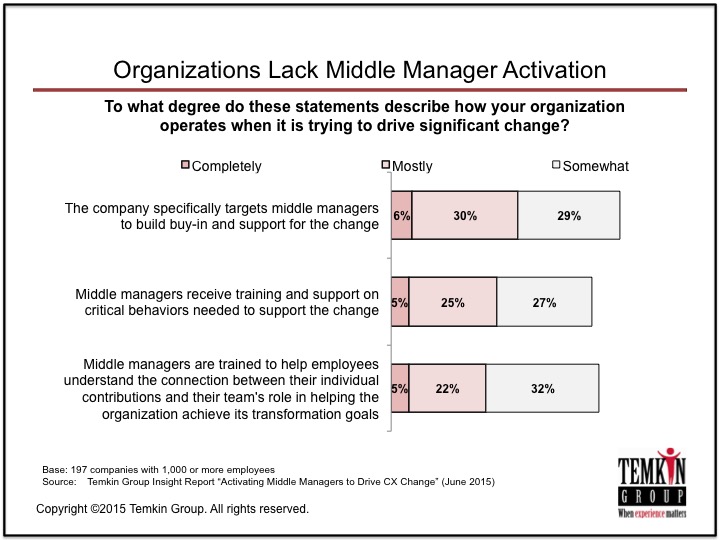Let’s face it: It’s hard to get any group of employees to change their behavior when their managers are still reinforcing old processes, measurements, and beliefs. Middle managers are the bridge between the vision and goals of senior leaders and the day-to-day work of the frontline employees. Middle managers are the ones who execute plans, lead teams, and direct collective efforts to produce results.
Smart companies recognize that middle managers are critical players during periods of significant change. Middle managers who are engaged and supported by their companies throughout the transformation can positively impact their employees’ understanding of and buy-in to the change, accelerate the adoption of new behaviors, and provide senior leaders with feedback about what’s working and what’s not. However, instead of supporting the company’s transformation, these key employees are seen as barriers to making changes. Why? Rather than being treated as a group that will bolster the organization’s success, middle managers are neglected during times of change. Temkin Group’s research with large organizations found that nearly two-thirds of them do not consistently target middle managers when trying to build buy-in and support for change. Furthermore, less than 30% of large organizations are training middle managers on the knowledge and skills they need to help guide employees through the change.
Temkin Group identified Activating Middle Managers as one of the five key strategies in a concept called Employee-Engaging Transformation (EET). We define EET as:
Aligning employee attitudes and behaviors with the organization’s desire to change.
To broaden our look at how organizations are explicitly enlisting the support of middle managers, I spoke to a number of companies and uncovered best practices that fall into five categories:
1. Involve middle managers in shaping the change: Help middle managers to personally embrace the change by soliciting their input about how the organization can best accomplish its change goals.
2. Engage middle managers in goal setting: Jointly set targets with middle managers for individual performance and team progress.
3. Train middle managers on key skills: Help middle managers gain the knowledge and capabilities needed to lead change and to succeed in their role in the new environment.
4. Provide middle managers with tools to engage their teams: Make it easier for middle managers to introduce, reinforce, and sustain the change by designing specific tools for that purpose.
5. Connect middle managers with customers: Shrink the gap between middle managers and the customers who will be experiencing the change.
In the course of my interviews, I heard a variety of examples of how companies are taking action to activate their middle managers across these five categories. I’d like to share some examples from one of those companies, ATB Financial, which activated its middle managers by:
• Involving middle managers by creating middle manager change champions. ATB Financial identified change champions to participate in crafting the rollout of its new brand story and culture. Executive VPs identified one or two individuals from their teams who were responsible for connecting frontline employees with executives. These champions provided input on how and where to talk about the change with employees in a way that best aligned with each respective groups’ points-of-view and situations.
• Making middle managers responsible for training their teams. ATB Financial’s branch managers were one of the earliest audiences to get exposed to the company’s new brand story and culture. Later, when the time came to launch the new brand story through a bank-wide livestream, middle managers were charged with leading local discussions with their teams immediately following the broadcast. Managers received a launch kit built around a series of questions to ask their teams, including “What does the story mean to us? How are we already doing some of the things the story talks about? What does this change for us?”
• Providing middle managers with tools that make it easy to recognize desired behaviors. ATB Financial’s Everyday Heroes program utilizes an online tool to recognize employees across a set of nine essential attributes. Senior leaders and middle managers are allotted a certain number of points each month to recognize employees’ performance, and employees can redeem accumulated points on selected prizes. This platform is also linked to an intranet site where employees can share their personal stories on how they are living the brand with customers.
Companies often overlook middle managers as an important group during times of change, with severe consequences. Don’t fall victim to that! Engage these key influencers and you’ll end up with middle managers who are not only invested in the transformation, but also understand their unique role in supporting their employees’ change journeys.




